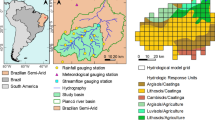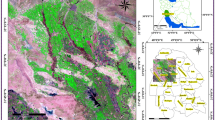Abstract
The Pingluo area, as an experimental study area in Yinchuan, has been subjected to major environmental degradation due to soil salinization problems. Soil salinization is one of the main problems of land degradation in arid and semiarid regions. In the present study, remote sensing was integrated with mathematical modeling to evaluate soil salinization adequately. To detect soil salinization, soil water content and electrical conductivity of soil samples were analyzed. The reflectance of soil samples was measured using a spectrometer (SR-3500) with 1024 bands. Indices of soil salinity, vegetation and drought were analyzed using Landsat images over the study area. Based on Landsat images, physicochemical analysis, reflectance of sensitive bands for soil salinization and environmental indices, canopy response salinity index (CRSI), perpendicular drought index (PDI) and enhanced normalized difference vegetation index (ENDVI), a new model was established for simulation and prediction of soil salinization in the study area. Correlation analyses and multiple regression methods were used to construct an accurate model. The results showed that green, blue and near-infrared light was significantly correlated with soil salinity and that the spectral parameters improved this correlation significantly. Therefore, the model was more effective when combining spectral parameters with sensitive bands with modeling. After mathematical transformation of soil reflectance, the correlations of bands sensitive to soil salinization were 0.739 and 0.7 for electrical conductivity and water content, respectively. After transformation of vegetation reflectance, the correlation coefficient of soil salinity became 0.577. After inversion of the model based on soil hyperspectral and water content, the significance became 0.871 and 0.726, respectively, which can be used to predict soil salinity and water content. The spectral soil salinity model had a coefficient of 0.739 for soil salinity prediction. Among the salinity indices, the CRSI was selected as the most significant, with R2 of 0.571, whereas the R2 for PDI reached only 0.484. Among the vegetation indices, the ENDVI had the highest response to soil salinity, with R2 of 0.577. After scale conversion, the correlation percentages between CRSI and measured soil salinity and between ENDVI and measured soil salinity increased to 16.2% and 8.5%, respectively. Following the correlation between PDI and soil water content, the percentage of correlation increased to 11.6%. The integration of hyperspectral remote sensing, ground methods and an inversion method for salinity is a very important and effective technique for rapid and nondestructive monitoring of soil salinization.











Similar content being viewed by others
References
Abd El-Hamid, H. T., & Hong, G. (2020). Hyperspectral remote sensing for extraction of soil salinization in the northern region of Ningxia. Modeling Earth Systems and Environment, 6, 2487–2493.
Abd El-Hamid, H. T., Kaloop, M. R., Abdalla, E. M., Hu, J. W., & Zarzoura, F. (2021). Assessment and prediction of land-use/land-cover change around Blue Nile and White Nile due to flood hazards in Khartoum. Sudan, Based on Geospatial Analysis, GEomatics, Natural Hazards and Risk, 12(1), 1258–1286.
Allbed, A., Kumar, L., & Aldakheel, Y. Y. (2014). Assessing soil salinity using soil salinity and vegetation indices derived from IKONOS high-spatial resolution imageries: Applications in a date palm dominated region. Geoderma, 230–231(7), 1–8.
Bajgiran, P. R., Darvishsefat, A. A., & Khalili, A. (2008). Using AVHRR-based vegetation indices for drought monitoring in the Northwest of Iran. Journal of Arid Environments, 72(6), 1086–1096.
Brunner, P. H. T. L. I., Kinzelbach, W., & Li, W. P. (2007). Generating soil electrical conductivity maps at regional level by integrating measurements on the ground and remote sensing data. International Journal of Remote Sensing, 28(15–16), 3341–3361.
Chen, H., Zhao, G., Chen, J., Wang, R., & Gao, M. (2015). Remote sensing inversion of saline soil salinity in the Yellow River estuary based on improved vegetation index. Transactions of the Chinese Society of Agricultural Engineering, 31(005), 107–114.
Chen, J. (1996). Evaluation of vegetation indices and a modified simple ratio for boreal applications. Canadian Journal of Remote Sensing, 22(3), 229–242.
Ding, J., Wu, M., & Liu, H. (2012). Monitoring of regional soil salinization based on comprehensive hyperspectral index. Spectroscopy and Spectral Analysis, 32(07), 1918–1922.
Douaoui, E. K. A., Niclas, H., & Walter, C. (2017). Detecting salinity hazards within a semiarid context by means of combining soil and remote-sensing data. Geoderma, 134(1), 217–230.
El-Zeiny, A. M., & Effat, H. A. (2019). Environmental analysis of soil characteristics in El-Fayoum Governorate using geomatics approach. Journal of Environment Monitoring and Assessment, 191, 463.
Feng, J. (2018). Scale effect analysis of soil salinization remote sensing modeling. Xinjiang University.
Feng, J., Ding, J., & Yang, A. (2018). Remote sensing modeling of soil salinization information in arid areas. Agricultural Research in Arid Areas, 36(01), 266–273.
Gao, B. C. (1996). NDWI: A normalized difference water index for remote sensing of vegetation liquid water from space. Remote Sensing of Environment, 58(3), 257–266.
Hereher, M. E., Salem, M. I., & Abd El-Hamid, H. T. (2010). Change detection of salt-affected soils at the coastal zone of the Nile delta using remote sensing. Egyptian Journal of Soil Sciences, 50(1), 11–123.
Hong, G., & Abd El-Hamid, H. T. (2020). Hyperspectral imaging using multivariate analysis for simulation and prediction of agricultural crops in Ningxia, China. Computers and Electronics in Agriculture Journal, 172, 105–155.
Jiang, H., Ding, J., & Tai, X. (2008). Extraction of salinized soil information in arid area based on ETM+ data. Journal of Soil Science, 2008(02), 222–228.
Khan, N. M., Rastoskuev, V. V., & Sato, Y. (2005). Assessment of hydrosaline land degradation by using a simple approach of remote sensing indicators. Agricultural Water Management, 77(1–3), 100–109.
Lei, L., Ding, J., & Jiang, H. (2014). Remote sensing monitoring of regional soil salinization based on measured hyperspectral and EM data. Spectroscopy and Spectral Analysis, 34(7), 1917–1921.
Lobell, D. B., Lesch, S. M., Corwin, D. L., Ulmer, M. G., Anderson, K. A., & Potts, D. J. (2010). Regional-scale assessment of soil salinity in the red river valley using multi-year modis evi and ndvi. Journal of Environmental Quality, 39(1), 35–41.
Niu, Z., Ding, J., & Li, Y. (2016). Extraction method of soil salinization information based on high score image. Arid Land Geography, 39(01), 171–181.
Qin, Q., Ghulam, A., Zhu, L., Wang, L., & Nan, P. (2008). Evaluation of modis derived perpendicular drought index for estimation of surface dryness over northwestern china. International Journal of Remote Sensing, 29(7), 1983–1995.
Scudiero, E., Skaggs, T. H., & Corwin, D. L. (2015). Regional-scale soil salinity assessment using Landsat ETM+ canopy reflectance. Remote Sensing of Environment, 169, 335–343.
Shi, Z., Wang, Q., Peng, J., Ji, W., Liu, H., & Li, X. (2014). Classification of hyperspectral reflectance characteristics of China’s main soils and spectral prediction models of organic matter. Science China: Earth Sciences, 000(005), 978–988.
Smedema, L. K., & Shiati, K. (2002). Irrigation and salinity: A perspective review of the salinity hazards of irrigation development in the arid zone. Irrigation and Drainage Systems, 16(2), 161–174.
Taxi, T., Zhang, F., & Ding, J. (2007). Spatial information of salinized soil in typical oasis in arid area. Arid Land Geography, 2007(04), 544–551.
Wang, F., Ding, J., & Wei, Y. (2017). Response analysis of salt index and vegetation index to soil salinity variability based on Landsat series data taking the typical oasis in the north and south of Tianshan Mountain in Xinjiang as an example. Chinese Journal of Ecology, 37(15), 5007–5022.
Wang, S., Ding, J., & Wang, W. (2016). Remote sensing monitoring of regional soil salinization based on surface spectral modeling. Arid Land Geography, 39(01), 190–198.
Weng, Y., Peng, G., & Zhu, Z. (2010). A spectral index for estimating soil salinity in the yellow river delta region of china using eo-1 hyperion data. Pedosphere, 20(003), 378–388.
Xu, D., Wang, S., & Cai, L. (2003). Application of NDVI index to identify crop and soil salinity distribution. Journal of Irrigation and Drainage, 2003(06), 5–8. https://doi.org/10.3969/j.issn
Yao, Y., Ding, J., & Zhang, F. (2013). Monitoring model of regional soil salinization based on hyperspectral index and electromagnetic induction technology. Spectroscopy and Spectral Analysis, 33(06), 1658–1664.
Zhang, C., Lu, D., Chen, X., Zhang, Y., Maisupova, B., & Tao, Y. (2016). The spatiotemporal patterns of vegetation coverage and biomass of the temperate deserts in central Asia and their relationships with climate controls. Remote Sensing of Environment, 175, 271–281.
Zhang, F. (2007). Spectral, spatial characteristics and composition of salinized land in oasis in arid area. Xinjiang University.
Zhang, F., Xiong, H., & Long, T. (2011). Comparative analysis of measured reflectance and image reflectance for soil alkalinization prediction. Spectroscopy and Spectral Analysis, 31(01), 227–232.
Zhu, T. (1992). Prevention and control of soil salinization in irrigation district (pp. 32–38). Agricultural Press.
Acknowledgments
This work was financially supported by Ningxia Natural Science Foundation (2021AAC03456); National Natural Science Foundation of China (41561078); Ningxia Natural Science Foundation (2018AAC03007); and Ningxia Key R&D Program General Project (2018BEG03069). The authors would like to thank the editors and anonymous referees for their valuable comments and suggestions.
Author information
Authors and Affiliations
Corresponding author
Rights and permissions
About this article
Cite this article
Wu, D., Jia, K., Zhang, X. et al. Remote Sensing Inversion for Simulation of Soil Salinization Based on Hyperspectral Data and Ground Analysis in Yinchuan, China. Nat Resour Res 30, 4641–4656 (2021). https://doi.org/10.1007/s11053-021-09925-2
Received:
Accepted:
Published:
Issue Date:
DOI: https://doi.org/10.1007/s11053-021-09925-2




